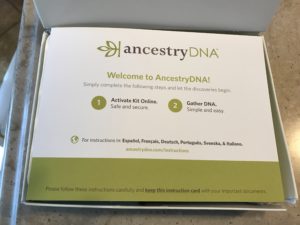 Ever since we worked so hard on family genealogies in 2015, Tom has wanted to have his DNA tested. According to family history, his grandmother was part Cherokee Indian and Tom hoped his DNA would prove it. I agreed to do it with him. So, shortly before Christmas, we ordered DNA kits from Ancestry.com and took the tests.
Ever since we worked so hard on family genealogies in 2015, Tom has wanted to have his DNA tested. According to family history, his grandmother was part Cherokee Indian and Tom hoped his DNA would prove it. I agreed to do it with him. So, shortly before Christmas, we ordered DNA kits from Ancestry.com and took the tests.
Once the DNA kits came in the mail, we opened them and read the instructions. First, Tom logged on to his Ancestry.com account and registered the kits, so we would know which was mine and which was his.
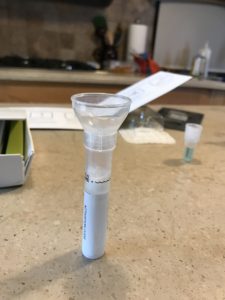 Next, we opened the kit and took out the small tube, attaching the funnel. The instructions say to spit into the tube until filled with saliva. The bubbles don’t count: the saliva bubbles have to be above the line. The directions say this is only one teaspoon of saliva. Tom was able to fill his tube with a couple of spits. I had a harder time. It took me almost 30 minutes to generate enough spit to fill the tube. I guess he’s just a better spitter than me.
Next, we opened the kit and took out the small tube, attaching the funnel. The instructions say to spit into the tube until filled with saliva. The bubbles don’t count: the saliva bubbles have to be above the line. The directions say this is only one teaspoon of saliva. Tom was able to fill his tube with a couple of spits. I had a harder time. It took me almost 30 minutes to generate enough spit to fill the tube. I guess he’s just a better spitter than me.
The third step was adding the fixing agent. We took off the funnel and attached a small lid filled with blue fluid. We shook this until it was thoroughly mixed with the saliva.
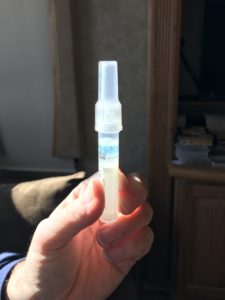 Finally, we put the tube in a sealed bag and inserted it into the addressed and postage-paid box. Once we sealed everything, we dropped it in the mail and waited for our results.
Finally, we put the tube in a sealed bag and inserted it into the addressed and postage-paid box. Once we sealed everything, we dropped it in the mail and waited for our results.
The results came about six weeks after we mailed the packages. My results were not a surprise at all. The results were exactly what I expected from the genealogical work we did previously: Western Europe (Germany) 45%, Great Britain 27%, Scots Irish (Celtic) 11%, Iberian Peninsula (Spanish) 8%, Other 6%. All of it coincided with the family stories and pictures.
Tom’s results were more of a surprise: Scots Irish (Celtic) 32%, Scandanavia 21%, Iberian Peninsula (Spanish) 20%, Western Europe 18%, and Great Britain 5%. According to the DNA results, he has no Native American DNA. So much for those family stories. He does, however, have 25% Spanish DNA. We didn’t find any Spanish people in his genealogy, so it must be in the lines of the family we were not able to trace. The results leave us wondering why this part of his heritage was hidden and where the family stories of being part Cherokee came from.
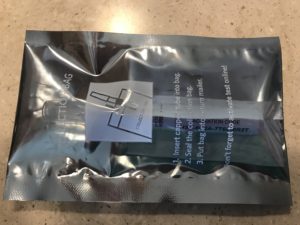 Of course, the DNA results are not 100% conclusive. It is possible for a grandparent to be Native American and none of the DNA to show up in a DNA test. We get all our DNA from our parents, but we don’t get it 50 – 50. Like dominant and recessive genes, we might inherit more DNA from one person than we get from another. This is why family traits, like red hair, might skip a generation or two and then suddenly pop up.
Of course, the DNA results are not 100% conclusive. It is possible for a grandparent to be Native American and none of the DNA to show up in a DNA test. We get all our DNA from our parents, but we don’t get it 50 – 50. Like dominant and recessive genes, we might inherit more DNA from one person than we get from another. This is why family traits, like red hair, might skip a generation or two and then suddenly pop up.
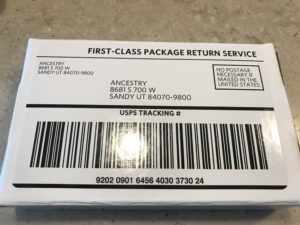 Taking the Ancestry DNA test was interesting. It confirmed some of our ideas and discredited others. The test also explained why we haven’t been able to trace any of Tom’s relatives back to a Native American. Of course, now Tom wonders if he might be descended from some conquistador that once roamed in the New World. I think it is just as well that we will probably never know.
Taking the Ancestry DNA test was interesting. It confirmed some of our ideas and discredited others. The test also explained why we haven’t been able to trace any of Tom’s relatives back to a Native American. Of course, now Tom wonders if he might be descended from some conquistador that once roamed in the New World. I think it is just as well that we will probably never know.
